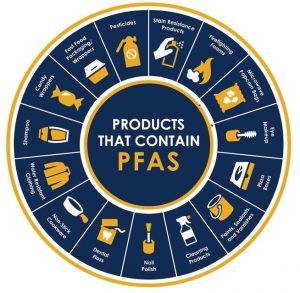
Infographic from The conversation.com
PFAS is a word thrown around a lot in the industry; but where does it come from? What harm can it cause? And how is the environmental sector combatting these issues now and in the future.
PFAS stands for per and poly-fluoroalkyl substances, which combines a large, complex group of manufactured chemicals that are ingredients in many everyday products. Their presence is everywhere, from non-stick frying pans to nail polish, pizza boxes to shampoo, and water-resistant clothing to fast food packaging.
PFAS chemicals resist heat, chemical and biological attack, and are very stable. This stability creates a problem as they have been found to be extremely persistent in the environment and within the human body, hence the nickname ‘Forever Chemicals’.
PFAS chemicals have been manufactured and studied extensively since the 1940s and there now more than 4000 recognised PFAS chemicals. Within the human body, PFAS has been linked to thyroid disease, liver damage, kidney cancer, and testicular cancer, as well as plethora possible developmental effects on unborn children. Here’s a simple explanatory video from EPA Victoria on PFAS and our health.

Effects of PFAS on human health infographic from European Environment Agency
So, what are we doing to combat PFAS?
- The PFAS National Environmental Management Plan (NEMP) is designed to achieve clear, effective and coherent approaches to the environmental regularion of PFAS in Australia1
- EPA Victoria is adopting a precautionary approach to PFAS and advising the population to reduce their own exposure to PFAS2
- EPA Victoria regulates the disposal, reuse, and management of PFAS affected materials (such as soil)
- Water filtration units making use of charcoal filters or reverse osmosis have been developed to remove PFAS chemicals from water
- New technology using a polymer-coated electrode has been developed to detect PFAS in water3
- PFAS monitoring and treatment is increasing worldwide. The United States Environmental Protection Agency has a raft of actions to address PFAS on its agenda4
- Research is occurring in all corners of the globe into the effects of PFAS on humans and the environment, as well as the technology required to combat PFAS. One local example is a joint PhD research project being conducted by the Toronto and Melbourne Research Training Group, which includes Melbourne University’s Centre for Anthropogenic Pollution Impact and Management (CAPIM)5
References:
- https://www.epa.gov/pfas/pfas-explained
- https://www.epa.vic.gov.au/for-community/environmental-information/pfas/pfas-national-environmental-management-plan
- (https://cen.acs.org/analytical-chemistry/chemical-sensing/Polymer-coated-electrode-detects-PFAS/98/web/2020/11)
- https://www.epa.gov/pfas/epa-actions-address-pfas
- https://capim.unimelb.edu.au/2021/12/06/phd-opportunity-toronto-and-melbourne-research-training-group/






